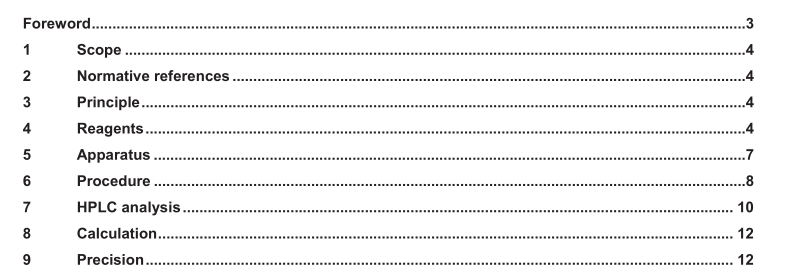EN 15891:2010 – Foodstuffs – Determination of deoxynivalenol in cereals, cereal products and cereal based foods for infants and young children – HPLC method with immunoaffinity column cleanup and UV detection

1 Scope
This European Standard specifies a method for the determination of deoxynivalenol (DON) in cereals (grain and flour), cereal based foods and cereal based foods for infants and young children by high performance liquid chromatography (HPLC) with immunoaffinity cleanup and UV detection. This method has been validated in three interlaboratory studies. The first study was for the analysis of samples of wheat, rice flour, oat flour, maize, polenta, and wheat based breakfast cereal ranging from 85,4 µg/kg to 1 768 µg/kg, the second study was for wheat and maize ranging from 165 µg/kg to 4 700 µg/kg and the third study was for cereal based foods for infants and young children ranging from 58 µg/kg to 452 µg/kg. For further information on the validation, see Clause 9 and Annex B.
WARNING — The use of this standard can involve hazardous materials, operations and equipment. This standard does not purport to address all the safety problems associated with its use.
It is the responsibility of the user of this standard to establish appropriate safety and health practices and determine the applicability of regulatory limitations prior to use.
2 Normative references
The following referenced documents are indispensable for the application of this document. For dated references, only the edition cited applies. For undated references, the latest edition of the referenced document (including any amendments) applies. EN ISO 3696:1995, Water for analytical laboratory use — Specification and test methods (ISO 3696:1987)
3 Principle Deoxynivalenol is extracted from the sample using water. The aqueous extract is cleaned up on an immunoaffinity column to remove impurities from the sample. Deoxynivalenol is then quantitatively determined by HPLC and UV detection.
4 Reagents
4.1 General Use only reagents of recognized analytical grade and water complying with grade 1 of EN ISO 3696:1995, unless otherwise specified. Solvents shall be of quality for HPLC analysis. Commercially available solutions with equivalent properties to the reagents listed may be used.
4.2 Disodium hydrogen phosphate, anhydrous or Na 2 HPO 4 ·12 H 2 O.
4.3 Potassium chloride, KCl.
4.4 Potassium dihydrogen phosphate, KH 2 PO 4 .
4.5 Sodium chloride, NaCl.
4.6 Sodium hydroxide, NaOH.
4.7 Hydrochloric acid solution, mass fraction w(HCl) = 37 % in water.
4.8 Hydrochloric acid solution, substance concentration c(HCl) = 0,1 mol/l.
Dilute 8,28 ml of hydrochloric acid solution (4.7) to 1 l with water.
4.9 Sodium hydroxide solution, c(NaOH) = 0,1 mol/l.
Dissolve 4 g of sodium hydroxide (4.6) in 1 l of water.
4.10 Phosphate buffered saline (PBS) solution, c(NaCl) = 120 mmol/l, c(KCl) = 2,7 mmol/l, c(phosphate buffer) = 10 mmol/l, pH = 7,4.
https://www.freestandardsdocuments.com/wp-content/uploads/2023/03/EN-15891.png